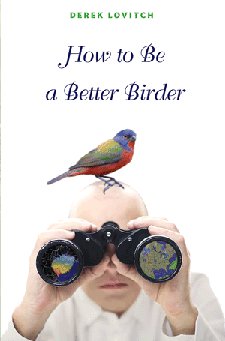Reviewed by Grant McCreary on May 21st, 2012.
I want to be a better birder. And I don’t think it’s too much of an assumption to state that most, if not all, other birders do as well. But what does it mean to be a better birder? I often think about it in terms of correctly identifying a greater percentage of birds encountered. But it could also mean finding more birds. Or it could simply be to enjoy birds more. Whatever it means to you, it’s likely that Derek Lovitch touches upon it in How to Be a Better Birder.
Lovitch starts with advanced field identification. Here, he describes a general framework for identification that he calls the “whole bird and more” approach – “Look at the whole bird, what it’s doing, and where it is doing it.” This chapter presents a good overview of how birding is changing from a detailed examination of a bird’s plumage to a more impression-based identification. While reading this chapter, I was struck by its remarkable similarity to the introduction of The Crossley ID Guide. The author even acknowledges this in a very amusing manner that includes snippets of a conversation he had with Crossley about the subject. This chapter, especially along with Crossley’s aforementioned text, just may be the boost you need to take your bird-identification skills to the next level, particularly if you’ve been primarily focused on plumage to make identifications.
From here, How to be a Better Birder moves on to “Birding by Habitat” and “Birding with Geography”. Identification and, especially, bird finding is discussed in regard to both of these factors. These chapters have the potential to be extremely helpful. However, I have to say that I’m still not sure how to apply some of the geography tips to my location. But even if you find yourself in the same position, just by providing the impetus to break out a map in the attempt to apply these principles, the author has done a good thing.
Every reader of this book will get more out of certain sections than others. For me, those chapters were “Birding and Weather” and “Birding at Night”. Yes, the latter will help you to literally bird at night by listening to the flight calls of migrants. But mostly, it covers figurative birding by means of radar. Lovitch explains how to use weather radar images – available for free online – to see when and where birds are migrating. This is not just cool, but it can inform your birding decisions. This book isn’t the first to cover these topics, but it has done the best job of explaining them that I’ve seen. If my experience in trying this for myself is any indication, it will still take a lot of practice. But it definitely seems worth it.
But, as they say, that’s not all. How to be a Better Birder also covers how to find vagrants, but then tempers that with an exhortation for patch listing. Additionally, it describes how to put your birding to good use through citizen science and conservation efforts. Actually, this may be the most important chapter of the book. I fully agree with the author’s statement that “birding can, and perhaps should, be about more than just putting a name on a bird and listing it”. This is a chapter that ALL birders should read and take to heart.
While reading and reflecting on How to be a Better Birder, I kept thinking about Joseph Hickey’s A Guide to Bird Watching. Although the topics covered by these two books are different (after all, they are separated by seven decades), their purpose seems very similar. Both present ways in which birders can expand their skills, and both urge their readers to do more than identify and list.
Recommendation
How to Be a Better Birder is an easy-to-read, even fun, exploration of the subject that picks up where resources targeted at beginners leave off. Any birder, regardless of skill level, can learn something from this book, but I think that intermediate and more advanced birders will get the most out of it.
Disclosure: I get a small commission for purchases made through links in this post.
Disclosure: The item reviewed here was a complementary review copy provided by the publisher. But the opinion expressed here is my own, it has not been influenced in any way.





Comment